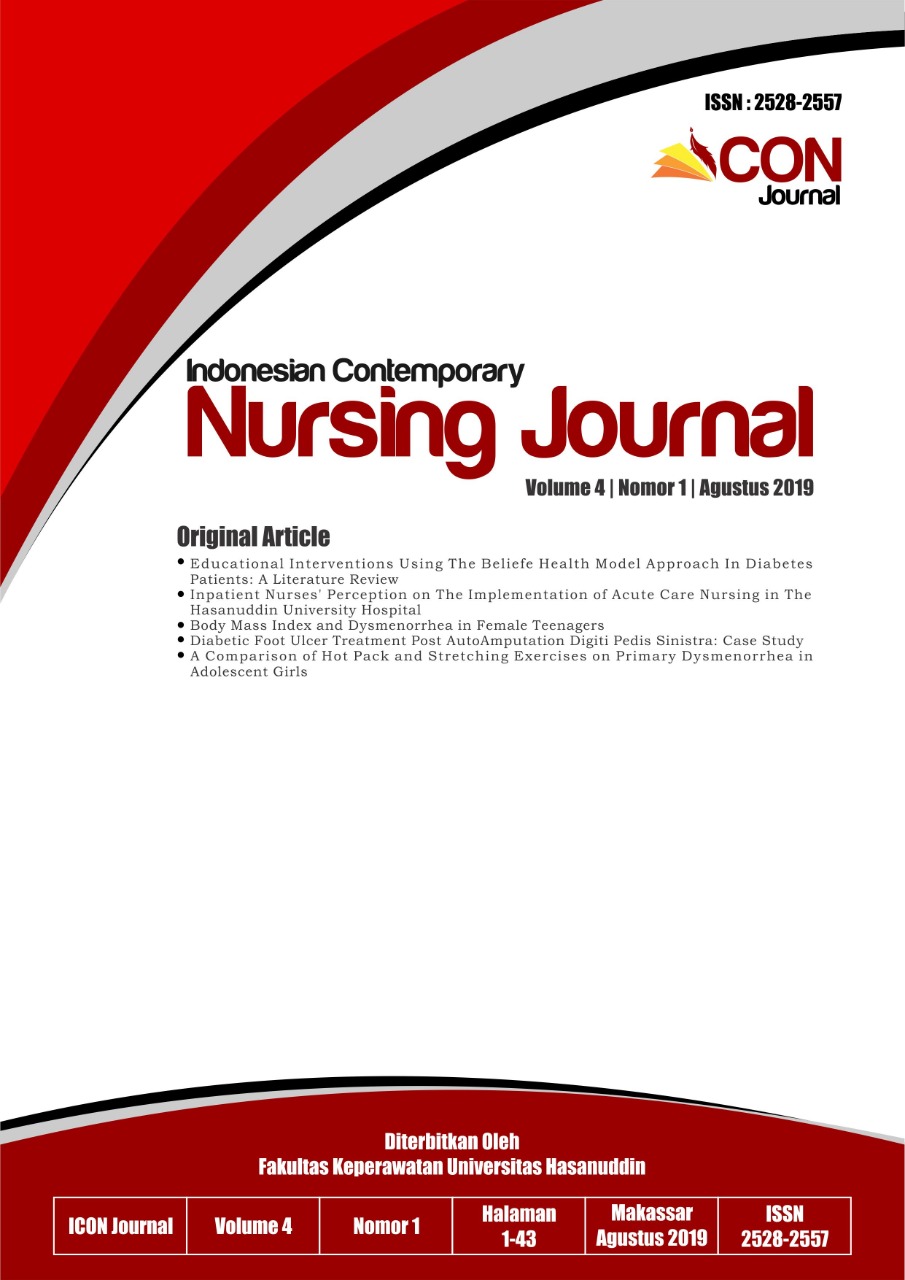Educational Interventions in Diabetics With the Use of Health Belief Models: Literature Review
DOI:
https://doi.org/10.20956/icon.v4i1.5038Abstract
The high prevalence rate in diabetes, causing diabetes is considered a health problem worldwide. Various studies related to interventions that can be done for diabetes sufferers have been widely carried out, including in terms of knowledge and education with the Health Belief Model (HBM) approach. The method used with the help of electronic data bases from journals that have been published through Pubmed, Wiley Online, Science Direct, Proquest, and Google Scholar. Results: 4 studies were included in the review, to assess the results of educational interventions in diabetics with the use of HBM. Conclusions and implications: It is known that the application of nursing education using the Health Belief Model concept framework has an effect on the self-management of diabetics so that it is expected to change patient compliance.
References
Abu-Qamar, M. Z. 2014. “Knowledge and Practice of Foot Self-Care among Jordanians with Diabetes: An Interview-Based Survey Study.” Journal of Wound Care 23(5): 247–54. http://www.magonlinelibrary.com/doi/abs/10.12968/jowc.2014.23.5.247.
Al-Qaddah, Reem Moh’d et al. 2016. “Knowledge and Practice of Foot Care among Diabetics at King Hussein Medical Center Jordan.” 23(3): 55–63.
American Diabetes Association (ADA). 2017. “Standard of Medical Care in Diabetes - 2017.” Diabetes Care 40 (sup 1)(January): s4–128.
Bayat, Fatemeh et al. 2013. “The Effects of Education Based on Extended Health Belief Model in Type 2 Diabetic Patients : A Randomized Controlled Trial.” : 1–6.
Conner, and Norman. 2003. “Predicting Health Behaviour, Research and Practice with SocialCognition Model.” In Buckingham: open univeristy pres.
DiGiulio, Mary, Donna Jackson, and Jim Keogh. 2013. Medical-Surgical Nursing Demystified. Second Edi. Mc Graw-Hill Education.
Dinesh, Peraje Vasu, Annarao Gunderao Kulkarni, and Namratha Kurunji Gangadhar. 2017. “Knowledge and Self ‑ Care Practices Regarding Diabetes among Patients with Type 2 Diabetes in Rural Sullia , Karnataka : A Community ‑ Based , Cross ‑ Sectional Study.”
Facchiano, Lynda, and Charlene Hoffman Snyder. 2012. “Evidence-Based Practice for the Busy Nurse Practitioner: Part One: Relevance to Clinical Practice and Clinical Inquiry Process.” Journal of the American Academy of Nurse Practitioners 24(10): 579–86.
Green, Edward C., and Elaine Murphy. 2014. “Health Belief Model.” In The Wiley Blackwell Encyclopedia of Health, Illness, Behavior, and Society, , 766–69. http://doi.wiley.com/10.1002/9781118410868.wbehibs410.
Hayden, and Joanna Aboyoun. 2014. Introduction to Health Behavior Theory. 2nd ed. Burlington: Jones & Bartlett Learning, LLC.
Ignatavicius, Donna D, and Linda Workman. 2017. Medical Surgical Nursing: Patient Centered Collaboration Care. 7th ed. St. Louis Missouri: Saunders Elsevier.
Jalilian, Farzad, Fazel Zinat Motlagh, Mahnaz Solhi, and Hasan Gharibnavaz. 2014. “Effectiveness of Self-Management Promotion Educational Program among Diabetic Patients Based on Health Belief Model.” 3(January).
Kowalak, Jennifer P, William Welsh, and Brenna Mayer. 2011. Buku Ajar Patofisiologi (Professional Guide to Pathophysiology). Jakarta: EGC.
Magbanua, Erva, and Rebecca Lim-Alba. 2017. “Knowledge and Practice of Diabetic Foot Care in Patients with Diabetes at Chinese General Hospital and Medical Center.” 32(2): 123–31.
Martins-Mendes, Daniela et al. 2014. “The Independent Contribution of Diabetic Foot Ulcer on Lower Extremity Amputation and Mortality Risk.” Journal of Diabetes and its Complications 28(5): 632–38. http://dx.doi.org/10.1016/j.jdiacomp.2014.04.011.
Mohammadi, Shooka, Norimah A Karim, and Ruzita Abd Talib. 2018. “The Impact of Self-Efficacy Education Based on the Health Belief Model in Iranian Patients with Type 2 Diabetes : A Randomised Controlled Intervention Study.” 27(November 2016): 546–55.
Moher, David et al. 2009. “Preferred Reporting Items for Systematic Reviews and Meta-Analyses: The PRISMA Statement.” PLoS Medicine 6(7).
Ogurtsova, K. et al. 2017. “IDF Diabetes Atlas: Global Estimates for the Prevalence of Diabetes for 2015 and 2040.” Diabetes Research and Clinical Practice 128: 40–50. http://dx.doi.org/10.1016/j.diabres.2017.03.024.
Pelicand, Julie, Cécile Fournier, Anne Le Rhun, and Isabelle Aujoulat. 2015. “Self-Care Support in Paediatric Patients with Type 1 Diabetes: Bridging the Gap between Patient Education and Health Promotion? A Review.” Health Expectations 18(3): 303–11.
PERKENI. 2011. “Petunjuk Praktis Terapi Insulin Pada Pasien Diabetes Melitus.” Perkumpulan Endokrinologi Indonesia: 1–37.
Shabibi, Parisa et al. 2017. “Effect of Educational Intervention Based on the Health Belief Model on Promoting Self-Care Behaviors of Type-2 Diabetes Patients.” (December): 5960–68.
Smeltzer C.Suzanne, Bare G.Brenda. 2013. Brunner & Suddarth’s Textbook of Medical Surgical Nursing. Tenth edit. East Washington Square, philadelphia, PA 19106 - 3780, USA: Lippincontt - Raven.
Stretcher, V, and I M Rosenstock. 2008. “The Health Belief Model.” Health Behavior and Health Education: Theory, Research and Practice: 31–36.
World Health Organization. 2016. “Global Report on Diabetes.” WHO 978: 88. http://www.who.int/about/licensing/%5Cnhttp://apps.who.int/iris/bitstream/10665/204871/1/9789241565257_eng.pdf.
Downloads
Published
How to Cite
Issue
Section
License
Authors who publish with this journal agree to the following terms:Authors retain copyright and grant the journal right of first publication with the work simultaneously licensed under a Creative Commons Attribution License that allows others to share the work with an acknowledgement of the work's authorship and initial publication in this journal.
Authors are able to enter into separate, additional contractual arrangements for the non-exclusive distribution of the journal's published version of the work (e.g., post it to an institutional repository or publish it in a book), with an acknowledgement of its initial publication in this journal.
Authors are permitted and encouraged to post their work online (e.g., in institutional repositories or on their website) prior to and during the submission process, as it can lead to productive exchanges, as well as earlier and greater citation of published work (See The Effect of Open Access).



